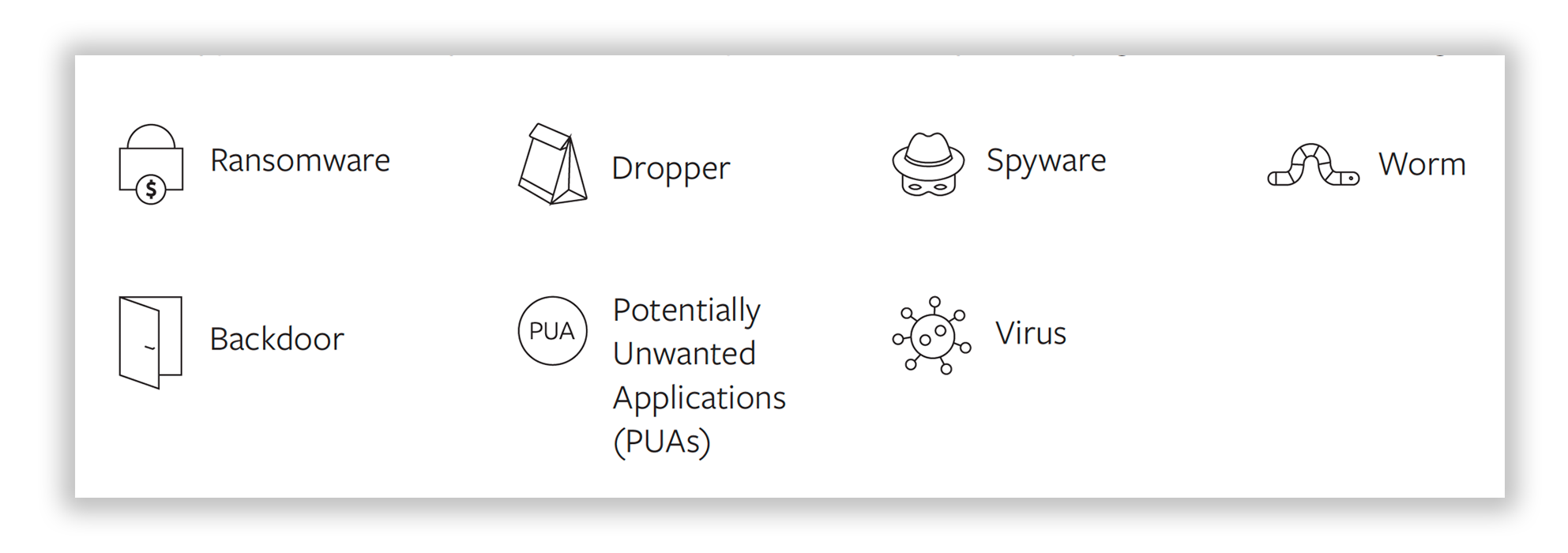Malware Threats
What are malware threats?
Malware threats include malware, viruses, and malicious code and are used to attack computers, devices, and larger IT environments.
Classification of Malware Threats - 7 Malware Family Types

There are different types of malware threats. Different types of malware threat classification include:
- Ransomware - A type of threat that encrypts, publishes, wipes, or blocks the victim’s data unless a ransom is paid.
- Backdoor - A type of threat that bypasses authentication, privileges, or encryption to access data, the computer, or network.
- Dropper - A type of threat (malware component) that installs malware on a target system.
- Potentially unwanted applications (PUAs) - A threat that compromises privacy, weakens the machine or network security, or downloads/installs additional content or presents ads.
- Spyware - A type of threat that gathers information about a machine, person, or organization without their knowledge.
- Virus - A type of threat that, when executed, replicates itself by modifying other computer programs and inserting its own code.
- Worm - A type of threat (standalone program) that replicates itself to spread to other computers.
Malware classification is a critical component to stop attacks early. When discussing classification, it is important to consider both known and unknown threats, like malware and zero-day variants.
Proper classification enables your SOC to:
- Prioritize critical threats and make determinations based on risk.
- Address critical threats with meta data and the threat severity rating.
- Assign critical resources appropriately, including staff and time to address security threats before opportunity.
How Does Deep Instinct Identify Malware Threats?
The Deep Instinct Prevention Platform identifies and stops known, unknown, and zero-day threats with the highest accuracy and lowest false-positive rate in the industry. For your organization, this means reduced risk, greater SOC efficiency, more complete security, and the knowledge that attackers have lost their advantage. Additionally, Deep Instinct is the only solution to provide deep classification to prevent threats before they infect your environment.
Deep Instinct provides a “Deep Classification” section in the Deep Instinct Management Console, which displays the breakdown of the malware sample, provides an analysis of the threat, and then reports back on the threat makeup.
By giving organizations and security professionals the capability to classify and rate threats in real time, teams can prioritize threats and respond more effectively to the threat alerts they receive. Security professionals need as much intel as possible to determine the best response to a perceived threat — and make this determination as quickly as possible.
Deep Instinct gives organizations the tools they need to spend less time researching threats and more quickly respond to the threats that matter.
Further Reading
- https://www.deepinstinct.com/pdf/whitepaper-malware-classification-in-threat-prevention
- https://www.deepinstinct.com/glossary/fileless-malware-attacks
- https://www.deepinstinct.com/glossary/fileless-malware-definition
- https://www.deepinstinct.com/prevent-fileless-malware
- https://www.deepinstinct.com/blog/types-of-dropper-malware-in-microsoft-office


